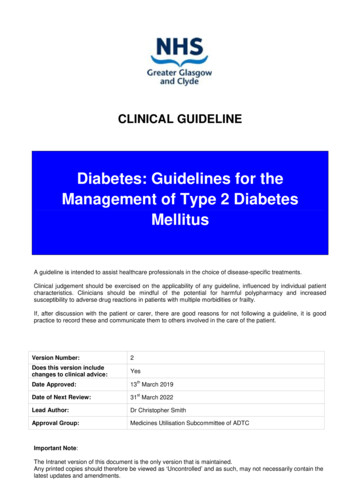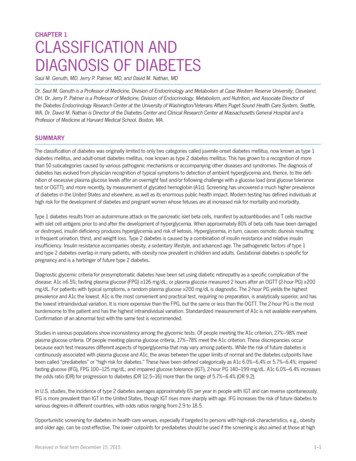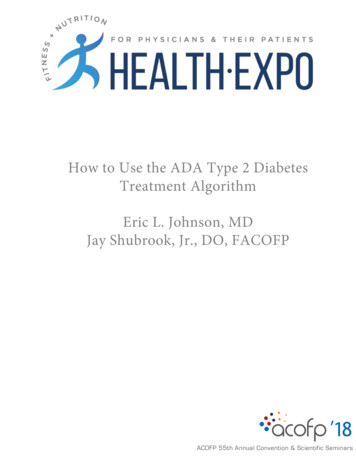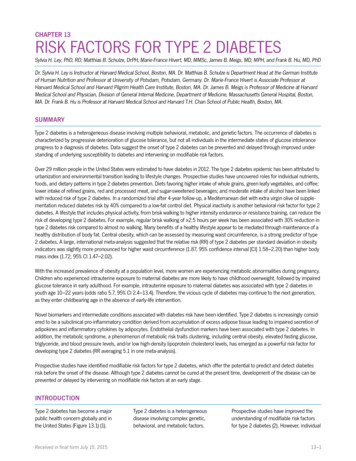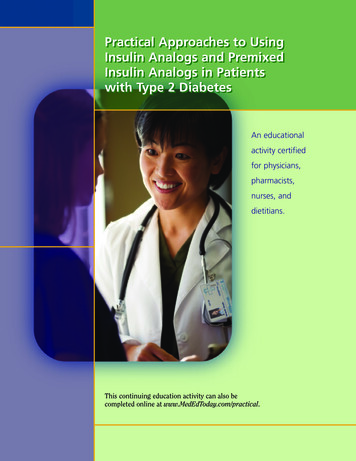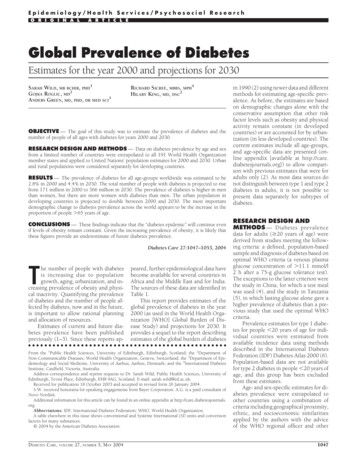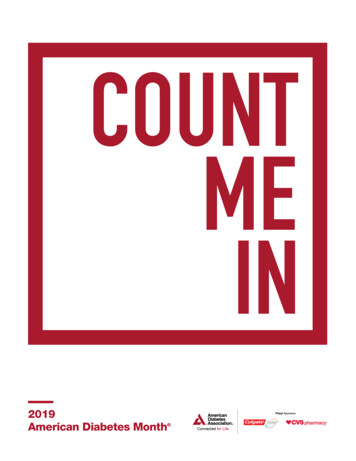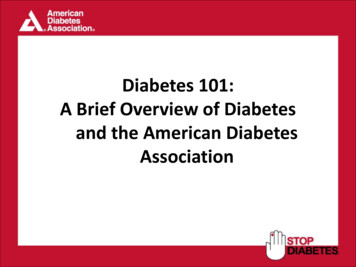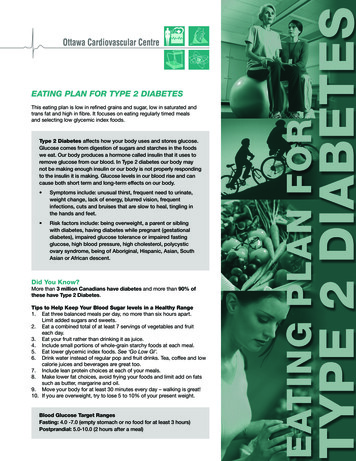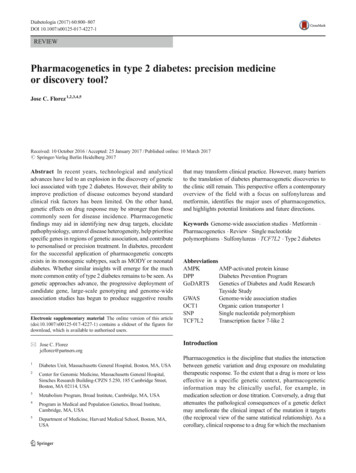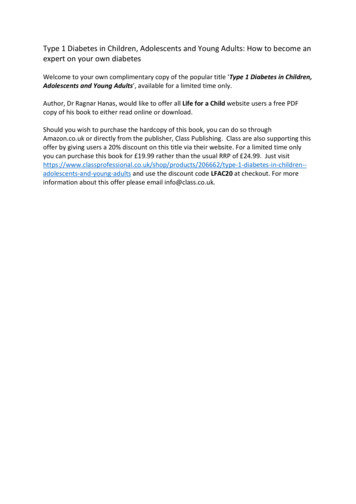
Transcription
Type 1 Diabetes in Children, Adolescents and Young Adults: How to become anexpert on your own diabetesWelcome to your own complimentary copy of the popular title ‘Type 1 Diabetes in Children,Adolescents and Young Adults’, available for a limited time only.Author, Dr Ragnar Hanas, would like to offer all Life for a Child website users a free PDFcopy of his book to either read online or download.Should you wish to purchase the hardcopy of this book, you can do so throughAmazon.co.uk or directly from the publisher, Class Publishing. Class are also supporting thisoffer by giving users a 20% discount on this title via their website. For a limited time onlyyou can purchase this book for 19.99 rather than the usual RRP of 24.99. Just s-and-young-adults and use the discount code LFAC20 at checkout. For moreinformation about this offer please email info@class.co.uk.
Comments on Type 1 Diabetes from reviewers“This is far and away the best diabetes resource I have ever come across. It has information you willnot find anywhere else and is well presented and indexed If you are serious about managing yourchild’s diabetes to the best of your ability, you cannot afford to do without this book.”Reviewer from London, featured on the Amazon website“I have no hesitation in thoroughly recommending this book to adolescents and young people withType 1 diabetes, their families and also to all healthcare professionals involved in their care.”Professor Martin Silink in Diabetologia“The information is clear, concise and extremely readable. All imaginable topics are covered fromhypoglycaemia, through pregnancy and on to psychological issues! It is difficult to imagine anyone,including healthcare professionals, teachers and grandparents, not learning something helpful.”Practical Diabetes International“It covers all aspects of living with diabetes and is one of the most useful and comprehensible bookswritten for the person with diabetes.”Paediatric Nursing“Congratulations to Dr Hanas on authoring a very comprehensive and informative book on type 1diabetes. This is the most complete book on living with type 1 diabetes available and takes the readerfrom understanding basic information to the complex.”Pediatric Diabetes
To my childrenMicke, Malin with little Runeand Marie with little Signe,and to my KarinYou may well feel that there is an overwhelming amount of knowledgeyou must take in, but nobody expects you to memorize the entirecontents of this book. If you use it as a reference, and read a little at atime, you will gradually get to grips with the information it contains.
TYPE 1 DIABETESin Children, Adolescents and Young AdultsHow to become an experton your own diabetesDr Ragnar Hanas, MD, Ass. Prof.Consultant PaediatricianSeventh editionfully revised and updatedCLASS HEALTH
Text and typography Ragnar Hanas 2019All rights reserved. Without limiting the rights under copyright reservedabove, no part of this publication may be reproduced, stored in or introducedinto a retrieval system, or transmitted, in any form or by any means (electronic, mechanical, photocopying, recording or otherwise), without the priorwritten permission of the author and publisher of this book.Ragnar Hanas asserts his rights as set out in sections 77 and 78 of the Copyright, Designs and Patents Act 1988 to be identified as the author of thiswork wherever it is published commercially and whenever any adaptation ofthis work is published or produced, including any sound recordings or filmsbased upon this work.Printing history:Authors: Ragnar Hanas, MD, Associate Professor, Uddevalla, SwedenFirst English edition, published by the author 1998Second UK edition 2004, reprinted 2005Third UK edition 2007Fourth UK edition 2010Fifth UK edition 2012Sixth UK edition 2015Seventh UK edition 2019The author and publishers welcome feedback from users of this book.Please contact the publisher:Class Health, The Exchange, Express Park, Bridgwater, Somerset TA6 4RRTel: 44(0)1278 427800Email: post@class.co.ukWebsite: www.classhealth.co.ukThe information presented in this book is accurate and current to the best ofthe author’s knowledge. The author and publisher, however, make no guarantee as to, and assume no responsibility for, the correctness, sufficiency orcompleteness of such information or recommendation. The reader is advisedto consult a doctor regarding all aspects of individual healthcare.Class Health is an imprint of Class Publishing Ltd.A CIP catalogue record for this book is available from the British LibraryISBN 978-1-85959-798-9Ebook ISBN 978-1-85959-799-610 9 8 7 6 5 4 3 2 1Edited by Richenda Milton-DawsDesigned by David Penfold and Ragnar HanasIllustrations and figures are reproduced with the permission of the respectivecopyright owner (see page 426). Additional cartoons by David WoodroffePrinted and bound in the UK by Bell and Bain Limited
ContentsComments on Type 1 Diabetes from reviewers . iPreface to seventh edition. xiType 2 diabetes. 28Untreated type 2 diabetes . 28Tablet-treated type 2 diabetes . 28Foreword by Dr Fiona Campbell . xii6. High blood glucose levels . 29Foreword by Dr Stuart Brink . xivWhat happens in the body when there is notenough insulin? .How to treat a high blood glucose level .Ketoacidosis .Blurred eyesight and diabetes.Acknowledgements . xvi1. Introduction . 12. Getting to grips with diabetes . 4When you first find out you have diabetes . 4Very young children . 6Routine check-ups. 7Living the life you choose. 83. Caring for your own diabetes . 9Goals for managing diabetes . 9How can you achieve these goals? . 9Becoming your own expert . 10Can you take “time off” from diabetes? . 11Alternative and complementary therapies . 124. Diabetes: Some background. 13Type 1 diabetes .Type 2 diabetes .Other types of diabetes.How common is diabetes? .Can you catch diabetes?.Does eating too many sweets cause diabetes?1313151617185. How your body works . 19Insulin.Your body doesn’t realize it has diabetes.The anatomy of your body .Pancreas .Islets of Langerhans.Cellular metabolism .A healthy cell.Starvation.Diabetes and insulin deficiency .202223242526262627303032337. Regulation of blood glucose . 34Counter-regulation.The liver.Glucagon .Adrenaline .Cortisol .Growth hormone.3435363941418. Hypoglycaemia . 42Blood glucose levels and symptomsof hypoglycaemia. 46Symptoms of hypoglycaemia whenthe blood glucose level is high . 48Severe hypoglycaemia . 48Seizures. 50Does severe hypoglycaemia damage the brain? 51Hypoglycaemia unawareness . 54Rebound phenomenon . 55Too little food or too much insulin?. 56Night time hypoglycaemia. 57Dawn phenomenon . 60Somogyi phenomenon . 61Will low blood glucose levels return tonormal if the child doesn’t wake up?. 62Can you die from hypoglycaemia?. 62Why does awareness of hypoglycaemia occur atdifferent levels of blood glucose? . 649. Treating hypoglycaemia . 67Practical instructions. 67Timing and hypoglycaemia. 70v
viType 1 Diabetes in Children, Adolescents and Young AdultsHelping someone with diabetes whois not feeling well .Glucose.Fructose.Sweets and hypoglycaemia.After hypoglycaemia.Learning to recognize the symptomsof hypoglycaemia .71717272737410. Insulin treatment . 76Intermediate-acting insulin . 77Intravenous insulin . 77Short-acting regular insulin . 78Rapid-acting insulin . 78Ultrafast-acting insulin. 79Basal insulin. 80Traditional basal insulins . 80Basal insulin analogues . 81Lantus (glargine) . 81Levemir (detemir). 81Tresiba (degludec) . 81Biosimilars. 82Pre-mixed insulin . 82A larger dose lasts longer. 82Units and insulin concentrations . 82Twice-daily treatment . 83Three-dose treatment . 83Multiple daily injections. 83Injections before meals (bolus insulin) . 85When should you take your premeal dose?. 85Combining boluses and basal insulin. 87Can I skip a meal? . 88Basal/bedtimeinsulin . 89When should the injection of basalinsulin be taken? . 89Insulin pump. 91Mixing insulins . 91Depot effect . 92How accurate is your insulin dose? . 92Insulin absorption . 93What happens if a child won’t finish a meal? . 93What if you forget to take your insulin?. 94What if you take the wrong type of insulin? . 96Having a lie in at weekends . 97Staying awake all night. 98Shift work. 99Birthday parties. 99Sleeping away from home . 100Insulin at school and day nurseries . 10011. Monitoring . 101How many tests should I take? .“Good” or “bad” tests? .Diabetes or not?.Are some things forbidden? .Urine glucose .Renal threshold .Blood glucose .How do I take blood tests? .Borrowing someone else’sfinger-pricking device.Does the meter show the correct value? .Children and blood glucose tests.Is it worth taking tests? .Does continuous finger-prickingcause loss of feeling? .Continuous glucose monitoring (CGM) .Ketones .Vomiting and ketones .Blood ketones 1812. The HbA1c test. 122What level should my HbA1c be? .How often should you check your HbA1c?.Can I measure HbA1c at home? .Can my HbA1c be “too good”?.HbA1c when travelling.Fructosamine .12212612712712812813. Injection technique . 129Getting used to injections.Injections for parents.Taking the pain out of injections .Where do I inject the insulin?.Is it necessary to disinfect the skin? .Storage of insulin .Syringes .Injections with syringes.Pen injectors.Why aren’t all insulins available in pens? .Replacing pen needles .Different pens for day and night time insulin.Variations in insulin concentration .Is it dangerous to inject air?.Insulin on the pen needle.Used needles and syringes 4. Injection equipment. 142Automatic injectors . 142Jet injectors . 142Indwelling catheters. 142
vii15. Adjusting insulin doses. 147Starting insulin treatment. 147How much does insulin lower theblood glucose level?. 151What to do if your blood glucose level is high 152Different ways of adjusting insulin doses. 155What about the food you eat? . 155Changing the content of the meal toaffect blood glucose. 155Changing insulin doses . 157Keeping good records . 159What is the best order for changing the doses usingMDI? . 159Premeal bolus doses. 159Insulin for breakfast . 159Insulin for lunch and dinner/tea . 160Insulin for evening snack. 160Holiday or weekday? . 161Physical exercise or relaxation? . 162Using rapid-acting insulin analogues. 162Always insulin before the meal!. 163Adjusting the basal insulin. 165High blood glucose levels . 166Hypoglycaemia. 167Exercise. 168Pre-mixed insulin . 169Short-acting regular insulin. 169Switching to rapid-acting analogues . 170Do you need regular insulinwhen using analogues? . 170Basal insulin . 171Night time insulin action . 171What should you do next? . 175High blood glucose in the evening? . 175Blood glucose levels at night. 175Night time hypoglycaemia. 176NPH basal insulin . 178Levemir. 178Lantus . 180Tresiba. 182Puberty . 182Insulin adjustments duringthe remission phase. 184Hypoglycaemia. 185Experiment!. 18616. Insulin pumps . 187Starting the pump .The basal rate.Temporary change of the basal rate .Premeal bolus doses.190191193194Change of insertion site .More frequent home monitoring .Pumps and sensors.Insulin depot with a pump .Ketones and ketoacidosis .Disconnecting the pump .Taking a bath or shower.Pump alarms.Occlusion or blockage alarm .Leakage of insulin .Air in the tubing .Sick days and fever .Pump removal doses.Admission to hospital .Physical exercise .Using the pump at night only .Is the pump a nuisance?.Does using a pump cause weight gain? .Having a lie in .Travel tips.Toddlers using pumps .Pregnancy .Rapid-acting insulin in the pump.Which type of treatment do the healthprofessionals prefer? 1921922022022122122222317. Side effects of insulin treatment . 224Pain.Insulin leakage.Blocked needles .Bruises after injections .Fatty lumps .Redness after injections .Insulin antibodies .Lipoatrophy .Insulin oedema .22422422422422522522622722718. Insulin requirements . 228How much insulin does your body need? .Puberty and growth .How much insulin does the pancreasproduce? .Remission (honeymoon) phase .Insulin sensitivity and resistance .Ideal insulin doses?.22822822922923123419. Nutrition. 236Absorption of carbohydrates. 238Emptying the stomach . 239Sugar content in our food . 241
viiiType 1 Diabetes in Children, Adolescents and Young AdultsTaking fluids with food.Dietary fats .Dietary fibre.Milk .Vegetables.Potatoes.Bread .Pasta .Meat and fish .Pizza .Salt.Herbs and spices .Fruits and berries.Glycaemic index .Mealtimes.Snacks .Can mealtimes be changed? .Hungry or full? .Infant feeding .Carbohydrate counting .Different methods of carbohydrateassessment .How many (or how few) carbsshould we eat? .School .Daycare.Special “diabetic” food? .Party time .“Fast food” .Food at educational camps.Vegetarian and vegan diets .Different cultures 21. Sweets, treats and ice cream . 272How much extra insulin should you take? .Ice cream.Chocolate.Sweets .Weekend sweets.Taking a break from eating sweets .Potato crisps.Chewing gum.28128228328323. Eating disorders . 28524. Physical exercise. 287Exercise and hypoglycaemia .Can the blood glucose level increasethrough exercise?.Hypoglycaemia after exercise .Physical education .Top level competitive sports.Keeping fit with diabetes.Camps and skiing trips .Marathon and other extreme sports.Adventure travel .Anabolic steroids.Diving .29029329429629730130330330330430425520. Sweeteners . 268Sugar-free?.Non-nutritive sweeteners .Nutritive sweeteners.Diet drinks and “light” foods .Satisfied or “feeling full”?.Reducing weight.The little extras.High HbA1c and weight loss.25. Stress. 308Stress in daily life . 30926. Fever and sick days . 311Nausea and vomiting.Gastroenteritis.Wound healing .Surgery.Drugs that affect blood glucose .Teeth .Vaccinations .31331431731731831831927. Smoking. 320Passive smoking. 321Giving up smoking. 322Snuff. 32227327527627627727828028028. Alcohol . 32322. Weight control . 28129. Illegal drugs . 326Alcohol and the liver .Why is it dangerous to drink too muchif you have diabetes?.Basic rules .What if you’ve had too much to drink?.Can you drink at home?.323323324325325
ix“Uppers”.Benzodiazepines .Cannabis .Opium.Hallucinogenics .Risk-taking behaviour .32632732732832832830. Pregnancy and sexual issues. 329Pre-pregnancy care . 331Caring for the mother. 332How will the child develop? . 333Will the child have diabetes?. 333Infertility . 334Will diabetes affect menstrual periods?. 334Sexuality. 334Contraceptives. 335Forgotten to take a pill?. 336Emergency contraception . 33731. Social issues . 338School .Day nurseries and child care.Child care allowance .Adoption .Choice of job or employment.Military service.Licence to drive .Driving and diabetes .Insurance policies .Diabetes ID .Juvenile Diabetes ResearchFoundation International .Children with Diabetes.Diabetes Associations.The National Service Framework forDiabetes (NSF).Sponsor families.Diabetes camps and educational holidays .Diabetes and the Internet.When does a young person becomean adult? .Reimbursed 835035035035135235232. Travel tips. 353Vaccinations .Ill while abroad? .Diarrhoea problems .Passing through time zones .35435535535633. Associated diseases . 360Coeliac disease.Thyroid diseases.
Type 1 Diabetes in Children, Adolescents and Young Adults: How to become an expert on your own diabetes Welcome to your own complimentary copy of the popular title ‘Type 1 Diabetes in Children, Adolescents and Young Adults’, available for a limited time only. Author, Dr Ragnar Hanas, would li

